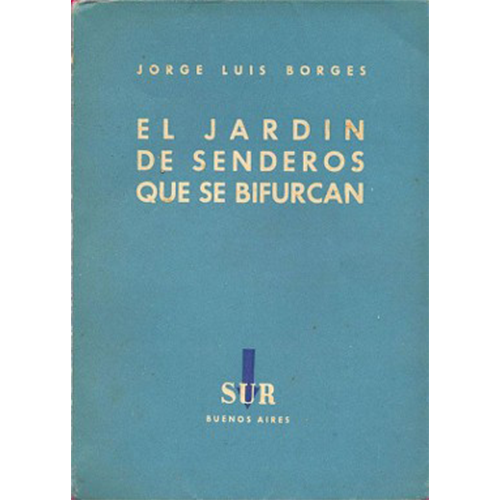Jorge Luis Borges
The Garden of Forking Paths

The Garden of Forking Paths is a small collection of short stories. This is the first time I’ve ever read Borges and it’s difficult to know what to say or think. The book contains five stories each with their own intricacies. It’s incredible how large of a world you can create with such a small amount of words. Each story has something that is confusing and mind boggling. You can feel it expand with every sentence, almost as if you’re walking through a winding room which seems to never end.
Each story stays glued to your mind after, wondering what you’ve just read. Even if you think you can comprehend it, another thought will have your mind elsewhere. The concepts are both simple but incredibly complex, I guess it depends how hard you think about it.
‘Absorbed in these illusory images, I forgot my destiny of one pursued. I felt myself to be, for an unknown period of time, an abstract perceiver of the world.’
The Garden of Forking Paths is based on the premise of a labyrinth of alternate realities, where each action and decision can be marked by different paths. This is representative of the story itself but also a book which is an embodiment of this concept. It twists your brain in a way that I’ve never felt from a short story before.
The second story, The Book of Sand, is about a mysterious book that seems to be infinite. Just like sand the book has no beginning or end, with muddled page numbers and illustrations never to be seen again. The more one looks the more pages appear making it impossible to find the same page. The new owner becomes obsessed with the book and eventually goes off to hide it in the depths of the Argentine National Library, ridding himself of the weight it has imposed on his life.
Forsake thy cage,Each story stays glued to your mind after, wondering what you’ve just read. Even if you think you can comprehend it, another thought will have your mind elsewhere. The concepts are both simple but incredibly complex, I guess it depends how hard you think about it.
‘Absorbed in these illusory images, I forgot my destiny of one pursued. I felt myself to be, for an unknown period of time, an abstract perceiver of the world.’
The Garden of Forking Paths is based on the premise of a labyrinth of alternate realities, where each action and decision can be marked by different paths. This is representative of the story itself but also a book which is an embodiment of this concept. It twists your brain in a way that I’ve never felt from a short story before.
The second story, The Book of Sand, is about a mysterious book that seems to be infinite. Just like sand the book has no beginning or end, with muddled page numbers and illustrations never to be seen again. The more one looks the more pages appear making it impossible to find the same page. The new owner becomes obsessed with the book and eventually goes off to hide it in the depths of the Argentine National Library, ridding himself of the weight it has imposed on his life.
Thy rope of sands,
Which pettie thoughts have made, and made to thee
Good cable, to enforce and draw,
And be thy law,
While thou didst wink and wouldst not see.
— George Herbert —
The third story is called The Circular Ruins and it explores the nature of reality and dreams, challenging the way we perceive the world. A man who attempts to dream another man eventually realises he is also a dreamt man. To be a phantom of another man’s mind, with our former memories wiped is of course dancing on the edges of our awareness. Infinite or not the story is laced with detail after detail, drawing you into something that can’t not have crossed your mind before.
The penultimate story, On Exactitude in Science, is the shortest story in this collection and is only a paragraph. It details the idea of maps being made exactly to their proportions, ‘a Map of the Empire whose size was that of the Empire’. A perfect map in this sense eventually being rendered useless. This story reminds me of themes from Seeing Like A State where much of our perception of the world has been shaped by the legibility of our maps. From our abstract measures to facilitate control, where is the boundary of utility?
The final story, Death and the Compass, follows a detective who is analysing a murder case after a rabbi is killed in his hotel room. He follows clues left by the murderer which end up happening every month from December to February. In the fourth month the detective notices a pattern, though after arriving at the place where he suspects there to be a fourth murder, he is captured by the criminals. After over-intellectualising the clues he is killed.
‘Centuries of centuries and only in the present do things happen; countless men in the air, on the face of the earth and the sea, and all that is happening is happening to me.’
All the stories within this book are incredible. References upon references are layered to give immense depth to such a short amount of words. It is difficult not to be in awe every time you read these stories, a really wonderful collection!